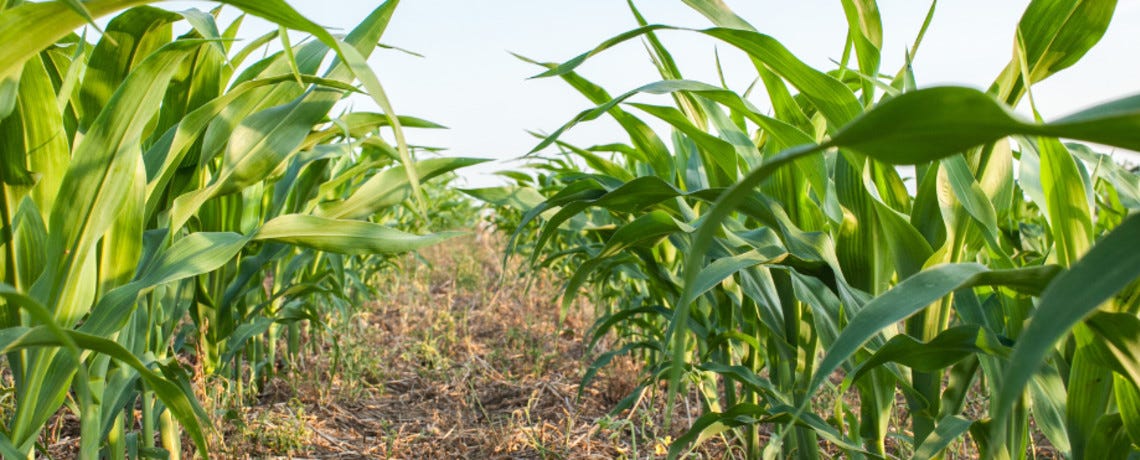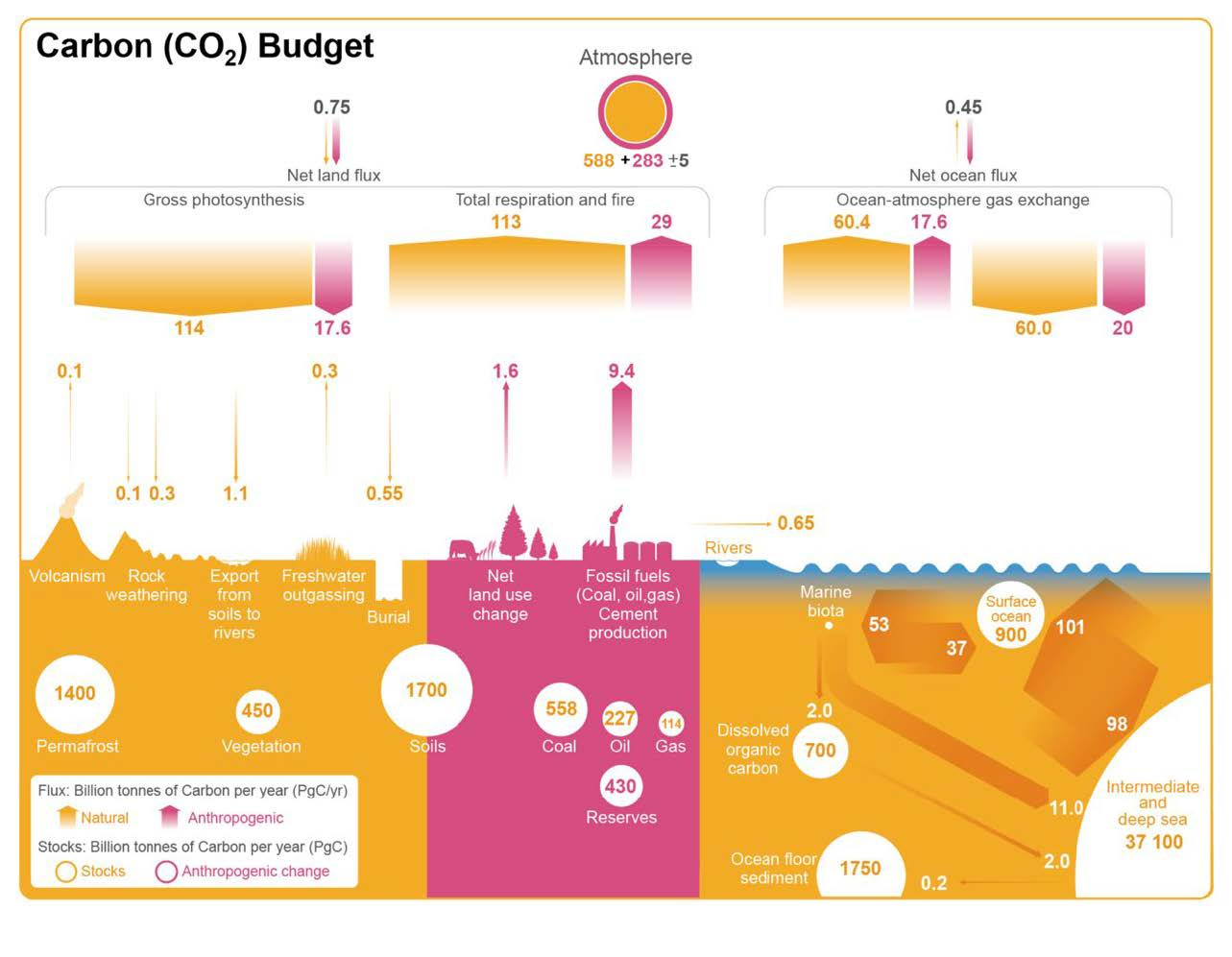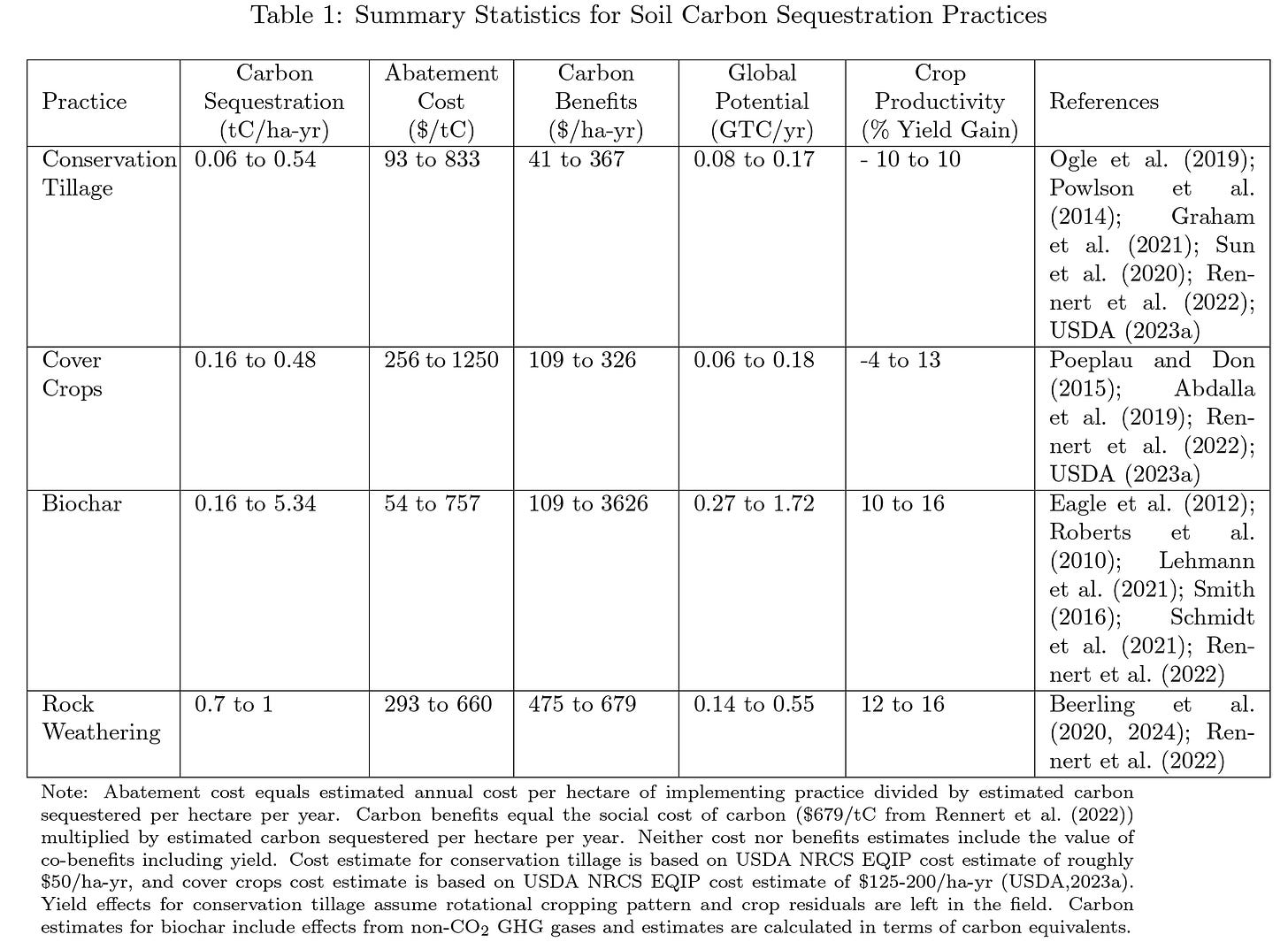Climate-Smart Agriculture Needs to be Smarter
We should put most of the ag climate money into research and development to increase productivity.

The US Inflation Reduction Act of 2022 includes $21.25 billion for climate change mitigation through climate-smart programs on farms. In 2022, the United States Department of Agriculture (USDA) spent $3.1 billion to support “commodities produced using climate-smart practices.” Multiple companies run carbon credit markets in which firms looking to offset their emissions buy credits from farmers who adopt “climate-smart” practices.
Will these initiatives do anything for the climate, or are they just giveaways?
Andrew Swanson and I have a new research paper coming out soon in the Review of Environmental Economics and Policy, in which we look under the hood of climate smart agriculture.
We focus on soil carbon. Global soils store 2,400 gigatons (GT) of carbon whereas the atmosphere contains only 830 GT. Every year, crops absorb about 17 GT of carbon from the atmosphere through photosynthesis, which is almost double the 9.4 GT emitted by burning fossil fuels. The vast quantity of carbon in the soil means a small-sounding 0.4% increase in soil carbon is needed to offset global fossil fuel emissions.
Sounds easy, right?
The three main practices farmers can use to increase soil carbon are (1) conservation tillage, (2) planting cover crops, or (3) spreading carbon amendments on soils.
Conservation tillage. Farmers till the soil to break it apart, which controls weeds, disrupts crop residue, and enhances soil profiles for seeding. However, tillage also allows oxygen to penetrate into the soil, which increases microbial activity and leads to CO2 respiration. By reducing tillage, farmers can allow carbon to accumulate in the soil and reduce erosion. More than half of US crop acreage uses conservation tillage (including reduced tillage and no-till).
Cover crops. Cover crops are non-cash crops grown between cash crop seasons. For example, US corn belt farmers may plant a crop such as rye or clover in the fall after completing the harvest and then terminate it the following spring in time to plant the next year’s cash crop. Cover crops can increase soil carbon stocks through two mechanisms: increased carbon inputs and reduced erosion. Only 5% of US cropland is cover cropped.
Carbon amendments such as biochar and ground-up rocks. Spreading carbon amendments on fields increases soil carbon if the added elements stay in the soil. In contrast to conservation tillage and cover cropping, which seek to manipulate the cropping carbon cycle, amendments bring carbon from outside the system. Biochar is a coal-like product formed from super-heating plant matter in the absence of oxygen. Rock weathering removes carbon from the atmosphere by the natural interactions of silicate minerals and water. Neither biochar and rock weathering have been adopted widely. They are expensive.
Soil carbon cycles make measuring and manipulating soil carbon stocks on working cropland exceedingly difficult. Practices like no-till may take decades to measurably impact soil carbon stocks and have already been widely adopted. Natural factors like climate and soil types create massive heterogeneity in outcomes.
The table below shows that the cost of sequestering (abating) a ton of carbon typically ranges from far below to far above the social cost of carbon. Thus, climate-smart practices could be beneficial on some fields (or parts of fields) and too expensive on others. However, soil carbon is very expensive to measure, so in practice we typically would not know how much carbon had been sequestered by a climate-smart practice.
In our paper, Andrew and I describe the large gap between what is possible and what is feasible given the twin challenges of heterogeneity and costly measurement. We also discuss the challenges of persistence — how much sequestered carbon is lost if a farmer stops the climate smart practice. The challenges are exacerbated by uncertainty about future policy, markets and science.
These challenges preclude the ideal policy, which would be a subsidy or tax based on the difference in carbon sequestration between a benchmark and a farmer’s planned schedule of future agricultural practices. Improving carbon models and spectral imaging, and otherwise reducing the measurement, reporting, and verification costs, would help improve policy efficiency. The Growing Climate Solutions Act is a small step in this direction. Economic researchers need to evaluate current policies relative to prospective policies that would attempt to overcome the challenges of heterogeneity, costly measurement, persistence, and uncertainty.
So far, I have ignored perhaps the largest way that agriculture affects greenhouse gas concentrations: land use change. Movement of land in and out of crops has large effects on soil carbon stocks. Gains from marginal changes in tillage or cover-cropping practices could easily be swamped by carbon losses from cropland conversion. To avoid such outcomes, continued increases in agricultural productivity are imperative.
A prominent 2010 paper by Burney, Davis and Lobell estimates that increased agricultural productivity from higher yields prevented up to 161 gigatons of carbon emissions since 1961. Moreover, they estimate that investments in agricultural R&D have reduced carbon emissions at a cost of $15 per on of carbon—a much lower cost than any of the practices listed in the above table. Investing more in research and development to increase agricultural productivity could provide a true win-win scenario of reducing climate change emissions while also increasing global welfare, but it faces a stiff challenge because the changing climate will likely reduce agricultural productivity growth.
I’m not saying we abandon climate smart practices, but the biggest payoff looks to be in R&D.
Andrew Swanson, my co-author on this work, received his PhD in agricultural and resource economics at UC Davis and is currently a postdoctoral scholar at UC Davis in partnership with the USDA’s Office of the Chief Economist. He’s on the job market this fall.
Two other UC Davis PhD students I advised are looking for jobs this fall.
Isy Picciotto is studying the effects of California irrigation efficiency subsidies on land, water, and energy use. She is also working on robotics and artificial intelligence in agricultural production.
Pedro Liedo is working on how tax avoidance affects the composition of the vehicle fleet and environmental quality in Mexico. He is also studying land use change caused by U.S. biofuel policies.
I highly recommend you check out each of their websites (Andrew, Isy, Pedro) and interview them. They’re great!






Next thing you know we'll have Bayer selling Apple a gigaton of "yield improvement" carbon credits at $1 a pop. But this is an interesting framing of the carbon impact of R&D that I hadn't really considered before.
As you know, biofuels have a very serious impact on indirect land use putting pressures to convert forests to agriculture. We could avoid the need for a whole lot of research by using the US land dedicated to biofuels for feeding people. Also “If all the grain currently fed to livestock in the United States were consumed directly by people, the number of people who could be fed would be nearly 800 million.” Unfortunately, the best solutions are hiding behind political change.